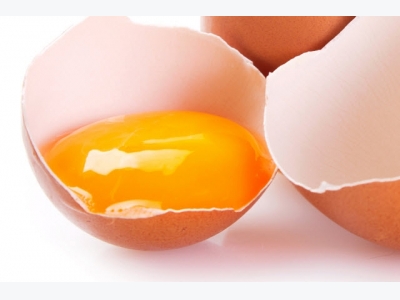Golden yolk colour comes from healthy hens

Colour is one of the most important factors that affect consumer choices through the sensory evaluation of food, including egg yolks. Optimal hen health is required for the efficient deposit of colour-influencing carotenoids in eggs.
Good results when rearing laying hens are greatly influenced by the birds’ viability and health. A good sanitary programme, including vaccination, must be implemented in order to obtain the best protection during the rearing phase. The poultry house environment parameters must also be managed in order to create the best conditions for the good welfare of the birds. Nevertheless, laying hens are sometimes affected by health issues due to parasites (coccidiosis), worms, viruses or pathogens that can affect the gut, in particular, thus hampering the absorption of carotenoids and leading to pale egg yolks. A bright yolk colour can therefore be considered as an indicator of the good health and performance of the flock.
Yolk and health
- The yolk consists of fats, proteins, vitamins, minerals and carotenoids.
- Carotenoids are responsible for the yolk colour. Besides colour, carotenoids play a role in bird reproduction, antioxidant and immune status.
- Absorption and assimilation of carotenoids, fats and lipo-soluble vitamins are strongly linked.
- In particular, any stress or disease that can affect the gut function would decrease it. The yolk will be pale.
- Therefore, only healthy hens will be able to produce a golden yolk colour.
Importance of carotenoids in bird health
In 1831, Wackenroder isolated the crystalline yellow carotenoid, then called carotene, from carrots and in 1837 Berzelius extracted the yellow carotenoids of autumn leaves and named them xanthophylls. Today, the carotenoid family is known to include over 750 compounds that provide different colours, from light yellow to dark red. When complexed with proteins, they can produce green and blue colorations. Historically, carotenoids have been known for their egg yolk colouring properties and have been thought to play specific roles in avian embryonic development. Nowadays, a growing body of research shows that, when specific carotenoids such as canthaxanthin are added to the diet, they can improve the anti-oxidant capacity of the eggs.
Carotenoids are divided into carotenes, carotenoids, which do not hold oxygen in their molecules, and xanthophylls or oxy-carotenoids. Carotenes are excellent sources of vitamin A. However, only less than 10% of known carotenoids can be converted into vitamin A. Clearly defined roles for non-provitamin carotenoids have still to be established, but evidence is emerging for several important functions, including anti-oxidant activities, cell signalling and transcription factor regulation, the promotion of cell differentiation, the regulation of cell proliferation and natural colouring properties.

Effects of carotenoid absorption and assimilation.
Dietary factors:
- Fat increases absorption and stimulates bile flow from the gall bladder
- Soluble fibre (e.g. pectin) interferes with uptake
- Aflatoxin and ochratoxin depress carotenoid absorption
- Vitamin A status (due to its effect on intestinal conversion)
- Protein level and status Iron and zinc status
- Dosage of carotenoid administered (reduced efficiency at higher levels)
- Competitive interactions between carotenoids
Food form
- Location in plant tissues (e.g. plant cell chloroplasts may be less bioavailable than chromoplasts)
- Mild heat treatment increases bioavailability
- Reduced particle size (i.e. blenderising) improves extractability
Biochemical & metabolic factors
- Isomeric form, but effect (positive versus negative) varies with carotenoid
- Large inter-individual variability, likely due to metabolic or absorption polymorphism
- Sex, age, hormonal status and season effect carotenoid metabolism
- Genetic make-up influences carotenoid metabolism (colour of Notherm Flicker has a genetic, not a dietary basis).
Subject characteristics
- Intestinal parasites associated with reduced absorption
- Coccidiosis, Newcastle disease or chronic respiratory disease decrease carotenoid assimilation
- Malabsorption syndromes (especially involving fat) reduce absorption
- Liver or kidney disease
- Increased gastric pH associated with suppressed blood response
- Environmental factors (captive vs wild)
Carotenoids role in display in plumage
It seems likely that sexual display and immune defences can be influenced by carotenoid availability, providing support for the hypothesis that males, allocated greater amounts of carotenoids for sexual coloration, thereby advertise their superior health.
In fact, the strategy of carotenoid allocation in wild female birds was associated with its display in plumage. So only healthy, fit birds can afford a substantial amount of carotenoids being directed to the plumage. Any health related problems (parasites, immunosuppression, oxidative stress, dietary deficiencies) would be associated with an increased carotenoid use for health reasons and therefore fewer carotenoids would be available for the display.

Figure 1- General scheme of intestinal absorption of carotenoids.
Carotenoid absorption
Carotenoid absorption from the intestinal tract is associated with the same intraluminal, membrane and intracellular events of dietary lipids. Despite gaps in our understanding of carotenoid absorption in avian species, it seems likely that in poultry most of the carotenoids are absorbed in the jejunum. Figure 1 shows a general scheme for the intestinal absorption of carotenoids. After the ingestion of feed, carotenoids are released from the matrix by digestive enzymes, including lipase, and further emulsified by bile salts and phospholipids, also involved in the emulsification of dietary triglycerides and other fat-soluble nutrients such as Vitamins A, E, K and D3.
Related news
 Parasite control can reduce hen mortality
Parasite control can reduce hen mortality A recent PhD study has investigated animal welfare in organic egg production and found an association between hen mortality and the level of parasite infection
 Can fly larvae replace synthetic methionine in organic egg systems?
Can fly larvae replace synthetic methionine in organic egg systems? Project to determine if feeding hens a diet supplemented with black soldier fly larvae will cause their eggs to taste or look different.
 Breeding resistant chickens for improved food safety
Breeding resistant chickens for improved food safety Test identifies roosters whose blood contains naturally high levels of cytokines and chemokines. Breeding resistant chickens for improved food safety